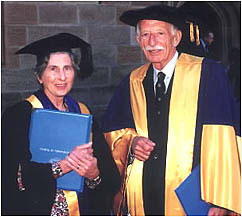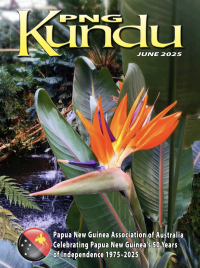Vale December 2002
HEALEY, Lionel Rhys, OBE(7 August 2002) | LINDSAY, David William (Bill)(19 August 2002) | MURRELL, Timothy George Calvert, AM(13 August 2002) | SADLO, Lothar(3 September 2002) |
SELBY, David(16 September 2002) | WRIGLEY, Brian William(6 August 2002)
Lionel Rhys HEALEY, OBE (7 August 2002, aged 81)
Rhys grew up in Sydney. As a schoolboy he travelled with the C of E Boys Society to sing in St Paul’s Cathedral, and also excelled in sports. While working in his first job, he was studying accountancy. He put his age up to join the army and served in Palestine and Syria. In 1943 he transferred to ANGAU and spent the rest of the war years in New Guinea running native hospitals. After discharge he joined the Health Department with responsibility for native hospitals and finally became their accountant. He was eight years in the Sepik District, five years in Chimbu and five years in Goroka. He was then posted to Port Moresby.
He then transferred to Education as Assistant Director Administration. After Independence he stayed for a further five years to help train staff working for Treasury. One of these was (Sir) Mekere Morauta, the former Prime Minister. He retired in 1981. That same year he was awarded an OBE. He also received an Independence Medal and was presented with the Gold Kumul medal for his long association with the Scouting movement. He was the second person to receive this medal. After retiring to Peregian Beach Rhys decided to become a tax agent but dementia caught up with him, so he and his wife moved to Brisbane. He is survived by his wife Dorothy, children Peter, Sharyn, Syvaun and Alastair, 16 grandchildren and two great grandchildren. Peter Healey
David SELBY (16 September 2002, aged 96)
A Tribute written by Bob Blaikie of Mt Gravatt, Qld, after reading David Selby’s lengthy and detailed obituary in The Australian of Tuesday 8 October.
David Selby was a judge of the Supreme Court of New South Wales and also a judge in divorce. He spent six months as an acting judge of the Supreme Court of Papua New Guinea in 1961-62. During one Supreme Court circuit Judge Selby, accompanied by his wife Barbara, spent a week with our family at Tari in the Southern Highlands where I was ADO. He describes his week at Tari in some detail in his book Itambu, a copy of which I have on my bookshelf.
Judge Selby said that Australia could be proud of the way in which so many of her officials, from the Administrator downwards, were tackling problems that called for the greatest skill. On the other hand he did not spare the pettiness of certain ‘Base wallahs’. He said that he never ceased to admire the work being done by the Administration officers in the field from the senior District Commissioners who were still mostly pre-war officials to the youngest Cadet Patrol Officers. He goes on to say that there was no mistaking their genuine dedication to an exacting task. He says that it is hard to avoid becoming cynical after years of life in the harsh and grasping cities but it is impossible, after living and working with these men, to fail to recognise that the spirit of real service to a cause is still very much alive. I am sure that quite a few others remember David Selby with affection and respect.
The following obituary was published in the Sydney Morning Herald on 3 October 2002, and is included with thanks to the Sydney Morning Herald and Jen Rosenberg.
A judge you’d follow into the jungle
David Mayer Selby, Judge, 1906-2002
After the fall of Rabaul in 1941, W.H. Lennard, the ABC’s war correspondent at Port Moresby, wrote: “Military officers in New Guinea are still talking about this man Selby and his unit. Selby’s fate is unknown. He may have been bombed out by the Japs – he may have destroyed his guns and escaped to the hills … But one thing is certain: Selby and his men behaved like heroes.”
David Selby’s accomplishments were so varied and so exceptional that they are in danger of overshadowing the person he was.
History will record Selby, who has died aged 96, as a man who excelled in every field to which he turned his hand, most notably the law, education and the military. What may not be recorded but will always be remembered by those who knew him were his humour, his devotion to his wife Barbara, and his great dignity.
David Mayer Selby was born in Melbourne, the second of five children of Herbert Basil Selby and Aimee Henriette (neé de Beer). The family moved to Sydney when he was a child. He grew up in Gordon and was educated at Shore.
Even as an adolescent, he used his irreverent sense of humour and love of pranks to his advantage. The headmaster at Shore was on the receiving end of a Selby special when young David took the opportunity of his parents being abroad and sent the headmaster the news that “David will not be returning to school”. Somehow this information was accepted and he was discharged.
Nonetheless, he graduated from Sydney University in arts in 1924 and law in 1927 and went to the bar in 1928.
University life offered him the opportunity to indulge all sorts of sporting and literary interests. He joined teams, acted with and wrote plays for the drama society, edited and contributed to the student publications.
The romance of fencing appealed to him, and he joined the Swords Club. To his horror, he found himself as a young solicitor’s apprentice crossing swords with the chief justice.
In March 1939 he married Barbara Phillips and in 1940 their first daughter, Alison, was born. But family and legal matters stood aside for the more pressing issue of World War II. Remarkably, all five Selby siblings served as officers during the war – and all returned safely.
Selby had joined the Sydney University Scouts infantry unit while an undergraduate, and transferred to the First Medium Artillery Brigade. In 1940, he volunteered for service in Papua New Guinea and was sent to command the anti-aircraft battery in Rabaul.
Selby and his men set sail for New Britain in August 1941, a militia unit of two officers and 52 men, mostly under 19, with two old-fashioned 3-inch guns and an obsolete ring-sight telescope.
They were to defend Rabaul alongside the men of Lark Force, the 2/22nd battalion of the AIF under Lieutenant-Colonel H.H. Carr, and No 24 Squadron of the RAAF, under Wing Commander John Lerew, who had the grand total of four Hudsons and 10 Wirraways at his disposal.
There was also a small RAN presence. In all, there were 1400 troops, just over 1000 of them fighting men.
On 4 January 1942, the Japanese began their invasion of Rabaul. As 18 bombers flew overhead, Selby’s gunners fired. They were the first shots to be fired at an enemy by a militia unit and the first shots to be fired by Australian troops on Australian territory. Carr sent Selby and his unit a grateful congratulatory note on behalf of “Little Hell” battalion, the soldiers’ name for Lark Force.
But their exhilaration was shortlived. One afternoon in the second week of January, 50 Japanese Zeros swept towards them. Lerew’s last six Wirraways took to the air but within minutes there was not an Australian left in the sky. On 22 January, Selby’s anti-aircraft guns went into action for the last time.
As Japanese ships steamed towards the island carrying aircraft and 20,000 enemy troops, it was clear that Rabaul was lost. There was no second line of defence, no plan for retreat.
Within a few hours the initial order, “There shall be no withdrawal”, became “Every man for himself”. Selby and his men destroyed their guns and, with most of the other Australians, headed for the jungle.
For the next three months, Selby led his men from one end of the island almost to the other, through jungle and across mountains. It was a near impossible task. They were always in danger of being discovered by the Japanese, and were often without food.
The men became increasingly ill – Selby, like many of the others, caught malaria but, fortunately, at a stage when there were still some quinine tablets left. They were injured and debilitated, their boots cut to shreds and their hope fading. One of Selby’s lowest moments was when he sought comfort in the photograph of his wife and baby and discovered that the jungle rivers had washed away the image.
Selby refused to surrender to the Japanese but, early on, some of his men chose to go with a group of officers and men from Lark Force to Tol Plantation to give themselves up. Logically, it was their best chance of survival, but they were massacred, bayoneted in the back.
The surviving prisoners from New Britain were put aboard two ships bound for Japan. The officers were on one ship, which arrived safely, and were repatriated after the war. The other ranks were put on the Montevideo Maru which the Japanese said was sunk with all hands by an Allied sub. The 1050 Australians on board were never seen again.
Selby battled on southwards, and eventually led his men to the safety of a plantation at Drina, where, suffering from malaria and malnutrition and more dead than alive, they waited for six weeks for a rescue ship which took them to Port Moresby. It is one of the great escape stories of the war and Selby vividly described it in his book Hell and High Fever (Currawong, 1956).
The war years had kinder cards to deal Selby: his second daughter, Elizabeth, was born in 1943 and his son, Bill, in 1945. After the war he served as chief legal officer, Eastern Command, retiring with the rank of lieutenant-colonel.
After the war, Selby’s legal career flourished. He was appointed Queen’s Counsel in 1960, then returned to Papua New Guinea the next year as acting judge of its Supreme Court. His book Itambu describes his difficult and rewarding tenure in a country struggling for nationhood.
In 1962 he was appointed to the Supreme Court of NSW to sit on the divorce bench and in 1964 was appointed judge in divorce where he remained until his retirement in 1975.
As a judge he was known throughout the profession and to many of the litigants who appeared before him for his unfailing courtesy and consideration. Justice Lloyd Waddy, in his speech of reply to his official welcome to the bench, said: “A great judge … Mr Justice David Selby is my ideal for gentlemanly courtesy on the bench. If I had an aspiration it would be to conduct a courtroom as relaxed but effective as he did, although I believe I could never fully attain his erudition and compassion.”
If anyone is proof that being involved and staying fit is the key to longevity, it is Selby. His extensive travels were not those of five-star hotels and cushy tours, rather of small ships around the Pacific and Asia, elephant riding in India and Ceylon, mountain climbing in Norway. As they finished school he took each of his children with him on one of his trips. When overseas travel became impossible he travelled around Australia.
When Alison was married she became his associate – a partnership both enjoyed tremendously until she left work to have the first of his seven grandchildren.
His grandchildren remember him as being tall and sometimes imposing, and always good for a story. As they grew older they found him to have a surprising understanding of life. While a conservative at heart, he also had progressive, modern attitudes and was always open to new ideas.
Selby’s 63-year marriage to Barbara was the bedrock of his life. Their enduring love, companionship and mutual respect was evident to all who witnessed it. Whether trekking the hills of Kashmir or powering through the daily crosswords or ending the day over the washing up, they were soul mates.
In the last year he was chuffed to welcome the youngest additions to the family, showing renewed interest in the life of babies. Chess and long stitch embroidery were hobbies he had taken up in his later years, and at the age of 95 he embroidered a large long-stitch picture for each of his three great-grandchildren. They, Barbara, their children, Alison, Elizabeth and Bill, seven grandchildren and his youngest brother, Benn, survive him.
Perhaps it was his lifelong involvement with Sydney University that kept him so in touch with young people. In 1964 he was elected to the university senate; he served as a fellow until 1989, during which time he was deputy chancellor from 1971 to 1986. During this time he was appointed an honorary fellow of International House.
In 1991 the university conferred upon him the rare honour of a doctorate of the university. He enjoyed the irony that he had not completed the Leaving Certificate.
Other fields of service included terms as member of the Bar Council of NSW, and the Medical Ethics Review Committee; chairman of the Marriage Guidance Council of NSW (now Relationships Australia); the Red Cross handcrafts committee; the Sydney University Arts Association; president of the University of Sydney Law Graduates Association; president of the Medico-Legal Association. Upon retirement he was given charge of the Parliamentary Remuneration Tribunal.
Even in his final years he subscribed to the Australian Ballet and the Sydney Symphony Orchestra. Those who dined with him before a show had to be on their toes to keep up with him as he made a sprightly dash from restaurant to Opera House, and always half expected that his unconventional path might lead them to the Green Room or possibly on stage.
Selby enjoyed a glass of wine. Indeed, he concludes his unpublished memoirs with “Nunc est bibendum” which may be freely translated as “Now for a drink.” After enjoying a glass of white wine at lunch to celebrate his 90th birthday, he was offered a glass of red with the main course and solemnly declined: “No thank you, I’m driving – I’d better stick to the white.”
Another day, he arrived at his bowling club to find members milling around looking skyward to the huge flagpole. He was told that the halyard was broken, and they could not get the flag down. Selby suggested calling the fire department, as their ladder would be tall enough to reach half way and they could nail the flag there, given that it spent so much time at half-mast anyway.
The president, not amused, said, “It will be your turn one day, Selby.” Well, that day has come. Jen Rosenberg
Jen Rosenberg is David Selby’s granddaughter. She has drawn on Hell and High Water for information about Rabaul.
A fellow judge described David Selby as an ideal for gentlemanly courtesy on the bench. At left, Selby with his wife, Barbara, in 1991, when he was awarded an honorary doctorate at Sydney University.
William (Bill) LINDSAY (19 August 2002, aged 76)
Bill was born and educated in Dundee, Scotland. At 17 he joined the British Army and served in Germany as a member of the Occupation Forces. After discharge he worked in the drapery trade in Dundee. In 1952 he was recruited by Burns Philp in Glasgow and travelled to Sydney by ship. In Sydney he was signed up to join the staff of Burns Philp in Rabaul. He was a relieving manager for many years and spent a long time in Kavieng, also Lae, Madang and Goroka.
Bill married May in Sydney in 1958 and they lived in Lae until they were transferred to Rabaul in 1960, where their two children were born. Bill was Drapery Manager in Rabaul until he and May retired to Takapuna, NZ, in 1978. Bill died at Takapuna after a short illness and is survived by his wife May, their daughter Alison (Hong Kong) and son Angus (South Johnstone, Qld). May Lindsay
Lothar SADLO (3 September 2002, aged 54)
Lothar Sadlo was a kiap, and later a clerk in Sydney and Canberra. He is survived by his wife Tricia, and children Tyson and Kynan. No further details available.
Brian William WRIGLEY (6 August 2002, aged 69)
Brian was a contract surveyor with PWD in the Southern Highlands in the early 60s. He was in Kundiawa in 1970. Later he and his wife Muriel ran a travel agency on Bribie Island before they moved to Caboolture, Qld. Muriel predeceased him. He is survived by his sons Simon, Phillip and Owen. Godfrey Grubb
Timothy George Calvert MURRELL, AM (13 August 2002, aged 69)
Professor Murrell discovered pikbel (enteritis necroticans) in the Highlands. He is survived by his wife Patricia, children and grandchildren. No further details available.
A full profile of Professor Murrell appears on the website of the Australian Medical Journal and can be viewed HERE





